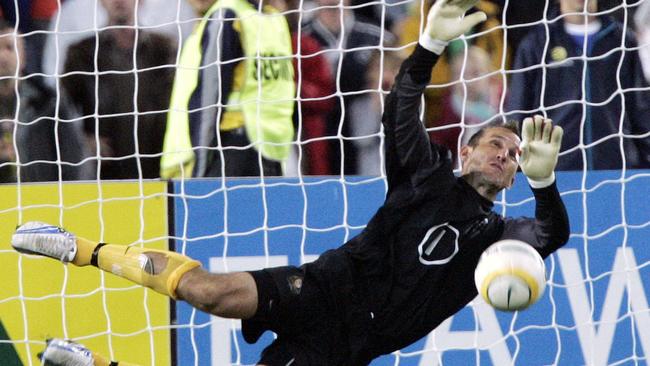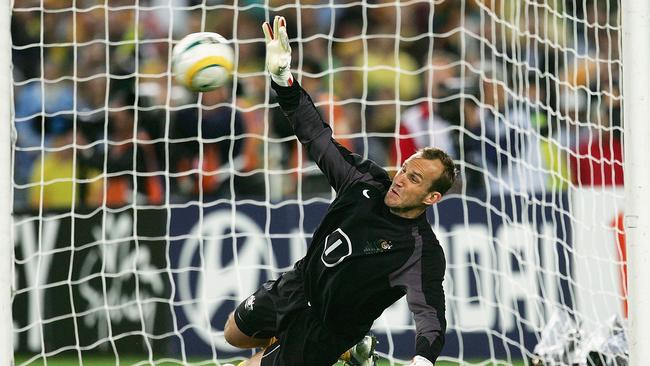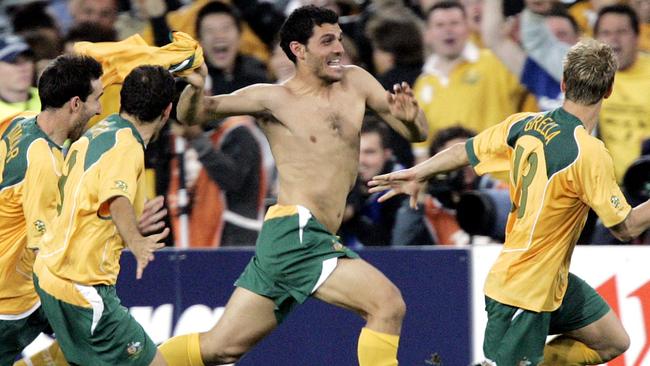Looking back at Australian football’s biggest night – 14 years on
It had been three decades since Australia had qualified for a FIFA World Cup, and after falling short four times, the Socceroos finally got their breakthrough which changed the landscape of Australian football forever.

Football
Don't miss out on the headlines from Football. Followed categories will be added to My News.
- WATCH: Al Hassan Toure scores first Australian goal
- How to get the most out of your Advertiser digital subscription
November 16, 2005 will forever live in Australia’s sporting hearts.
It’s the day the Socceroos defeated Uruguay in a penalty shootout to qualify for their first FIFA World Cup in over three decades.
Australia was in the midst of its golden generation, yet had little to show for it.
It boasted stars like Liverpool winger Harry Kewell, Middlesbrough duo Mark Schwarzer and Mark Viduka, Blackburn’s Brett Emerton and Lucas Neill, and 25-year-old Everton forward Tim Cahill, yet those stars hadn’t made it to a World Cup.
The Socceroos had previously made it to the playoff final after qualifying through Oceania, and had fallen to Uruguay in 2001, Iran in 1997, Argentina in 1993 and Scotland in 1985.
Australia had lost the first leg in Montevideo, Uruguay 0-1, courtesy of a Dario Rodriguez goal.
Fox Sports commentator and author of ‘That Night’ Adam Peacock looked back how the night unfolded.
Stream live coverage of the 2022 FIFA World Cup Qualifiers with Fox Sports on KAYO. Get your 14 day free trial & start streaming instantly >
“Among the group was a sense of calmness, because they went into this as mature players and mature for the situation they were walking into,” he said.
“They made sure planning was done right, it was done like a military-style operation to make sure the players got the most out of themselves on that night.
Having experienced heartache against Uruguay four years earlier in the 2002 World Cup qualifiers, the Socceroos were aware of who they were up against.
However, they enjoyed some good fortune when a Uruguayan star, who was playing with Spanish side Villarreal at the time, missed the second leg with injury.
“They knew how good they were and how battle hardened they were,” Peacock said.
“Diego Forlan got injured, he couldn’t play in Sydney.
“They encountered an opponent very difficult to beat, but they lacked that cutting edge, and they had prepared themselves well enough.”
Australian manager Guus Hiddink had made the controversial decision not to start Kewell, but it was a move that paid off as he played a part in Mark Bresciano’s equaliser in the 35th minute.
“It was a feeling of elation (when he scored), the first half an hour was a little sketchy, it was an ugly game of football,” Peacock said.
“It wouldn’t be in the top thousand games to watch, but as far as dramas it’s one of the top games ever.

“The first half-hour, Uruguay had a few chances and couldn’t quite get things going, and Tony Popovic got an early yellow card, which could’ve been a red card.
“Guus made the call to bring Kewell on after half an hour, and he wanted to prove his manager wrong and he wanted to prove a few things out there.
“It had an immediate effect.”
After Bresciano’s goal, neither side could find a winner in normal time or extra-time, meaning it was going to penalties.
While John Aloisi was ultimately the penalty-scoring hero, goalkeeper Mark Schwarzer was just as good.
However, it was close to not being Schwarzer in net for the shootout.
“It was ridiculous tension, the crowd,” Peacock said.
“I’ve watched the game back without commentary and you could feel the tension and the noise.
MORE NEWS
Timmy exit forces Socceroos to adopt different goals
Verbeek declares ‘war’ if Mariners play star Olyroo
Fowler is the real deal, says Adelaide United boss
“When it went to penalties, Schwarzer had to step up and he knew Guus Hiddink had tried to substitute him as Zeljko Kalac was warming up.
“If Brett Emerton hadn’t cramped, Zelkjo would’ve come on for Schwarzer.
“It was the ultimate sliding doors moment for Mark Schwarzer, he’s got a bit to thank Brett Emerton for.”
Kewell had scored the Socceroos’ first penalty before Dario Rodriguez, who scored the goal in the first leg, had his strike saved by Schwarzer.
Lucas Neill and Tony Vidmar converted next for Australia, while Gustavo Varela and Fabian Estoyanoff did the same for Uruguay.
“There was still a job to do (after Rodriguez’s miss),” Peacock said.
“Mark Viduka steps up and misses everything. If you had to trust one guy to score, it’s our greatest ever striker.”

“Then John Aloisi, and there’s a great story about him, in 2001 he said he didn’t play the part he wanted to play, he called home after the loss and said ‘one day, I’m going to score the goal to take us to the World Cup’.
“He asked the team manager the day before where all the family were sitting in the stadium, and that’s why they did that massive running celebration.”
The Socceroos would eventually go on to make it to the round of 16 in the World Cup, before being knocked out by eventual winners Italy.
But 14 years on, that penalty shootout has been the springboard for Australian football at a time it was in a tough spot.
“I’d hate to think (if it went the other way),” Peacock said.
“We lived through it before with Iran in 1997 with how close we got, but it would’ve been that and a little bit worse.
“It was big in the sense, yeah we set up football, the A-League and had got into Asia, but you needed something that could hit you between the eyes straight away and take away from the demise of the NSL.
November 16, 2005.
— Caltex Socceroos (@Socceroos) November 15, 2019
On this day, we defeated Uruguay in one of the most iconic moments in Australian sporting history.
Re-live it all below. pic.twitter.com/nJ6TCzy7bS
“The game needed this big, big thing to happen to show everyone, it’s no point saying the world game when you aren’t part of the world game, which is the World Cup.
“To qualify then and there for it with everything else going on was huge.”
Since 2006, Australia has qualified for the next three World Cups, and Peacock said a lot has changed in expectation since that shootout win.
“The A-League, while it’s not perfect, is better than it was,” he said.
“The Socceroos now have this expectation to qualify, and we’ve done so every World Cup since.
“You can’t seriously call yourself a big football nation if you’re not qualifying.
“Asia is more difficult than what we used to do, but 14 years on, the sport is in a better place and that was a bit of a reason why.”
Upon watching parts of the match again, Peacock said there was one particular moment that still stands out, and it isn’t the penalty shootout.
And furthermore, re-live one of the great moments of that night... the Uruguay anthem.
— Adam Peacock (@adampeacock3) November 16, 2019
They gave it to us, we gave back. With all due respect â¤ï¸ðŸ‡ºðŸ‡¾
(And those who think this is bad sportsmanship, please, take your unicorn for a gallop)https://t.co/FtqBILfSUH
“I watched the Uruguay national anthem, and that is one of the best sounds in Australian sporting history. They booed us, and we gave it back.
“We knew it was going to be different and this confirmed it.
“I still get tingles looking at that, thinking this is bigger than big.”
Originally published as Looking back at Australian football’s biggest night – 14 years on
